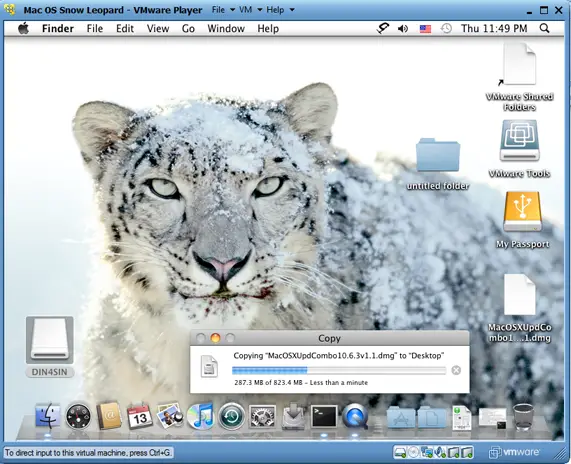
- Mount mac os x dmg in vmware how to#
- Mount mac os x dmg in vmware mac os#
- Mount mac os x dmg in vmware install#
- Mount mac os x dmg in vmware update#
Note 2: In order to stop the Mac VM from crashing each time Energy Power management for display and hard drives to kick in, I had to set the Display, Screen Saver and hard drive shutoffs to "Never". Note 1: For me to have a full screen display, I was able to specify "Graphics Mode"="1600x900x32" at the Leopard boot prompt. You can enter boot parameters or press enter with a standard boot.
Mount mac os x dmg in vmware install#
Download Debian 9 Images for Virtualbox and VMware Install MacOS Mojave on Vmware, Virtualbox, and PC. This will bring you to the Leopard Boot prompt. Mounting a Disk Image File (DMG) from the Terminal. At the boot prompt use device "80" (again no quotes) and press enter.Ĩ. When the installtion is complete, change the VMWare mounted image back to the vmdonk.iso file that was previously mounted. You will have to partition your drive using the Disk Utility. Install leopard by following the instructions. This will give you the Leopard boot prompt.ĥ. First head over to this website and grab yourself a copy of dmg2img by clicking on the win32 binary link.
Mount mac os x dmg in vmware how to#
Here’s how to convert a DMG file into an ISO file that can be mounted on a Windows PC.
Mount mac os x dmg in vmware mac os#
This will try to boot from the Leopard ISO image. The DMG image format is by far the most popular file container format used to distribute software on Mac OS X. Change the VMware settings and mount the Leopard ISO image, by using the VM->Removable Devices menu item.Ĥ. Boot the system with the vmdonk.iso attached. Extract the CD image template from #2 above.Ģ. This blog does not contain instructions or locations where retail DVD of Leopard can be obtained.ġ. We recommend you go thru legal channels of course. Download and install the template for the guest CD image from /?id=292X457&url=http%3A//3. I used VMWare Workstation for Windows 6.5.0 build 118166Ģ. The feature is documented in the manual page for hdid, the command line program that is used by hdiutil to do the actual mounting.After many days of trial and error, I was finally able to install MacOS X 10.5.5 from a retail DVD version of Leopard on my VMWare workstation 6.5.6.ġ.

Useful if you only need to retrieve a file or two using Pacifier.
Mount mac os x dmg in vmware update#
That command will mount the disk image containing the 45 MB large combo update to 10.1.5. MacOSXUpdateCombo.10.1.5.dmg.bin" NOTE: Shown on multiple lines for narrower reading type on one line with no additional spaces in order to use the command. To mount a disk image remotely, enter the following command in Terminal: % hdiutil mount ""For example: % hdiutil mount "ġ388/061-0008.20020604//Apple_Support_Area/Īpple_Software_Updates/Mac_OS_X/downloads/061-0008.20020604/ Secondly, it avoids cluttering the hard drive with disk image files. This can be a real time-saver if you are on a modem trying to download just a few files from a huge disk image. If you want to view all the files select on All and if not select the file type. Step 3: Now, you can see two options on the screen select any as per the need.



Step 2: Click on the Scan button to add single or multiple. Firstly, it allows selective downloads of just the interesting files from a disk image. Step 1: After downloading, open the application on your system. Update: This worked for me, too (after modifying the last mv command). With AnyToISO program you can convert DMG to ISO and mount the resulting ISO image to your virtual machine (running Mac OS X). There are several reasons why one may want to mount a disk image remotely. DMG is Mac OS X native disk image format while virtual machines (VmWare, Parallels or VirtualBox) are able to mount ISO images only. However, this feature is not available in Disk Copy, so one must resort to the Terminal for mounting remote disk images. For many users, the easiest way to unmount a drive in Mac is to either just drag a volume into the Trash, use the eject keys, disconnect the drive, or use one of the force eject methods. A little known capability of Mac OS X disk image system allows remote mounting of most disk images directly from " URLs. You can mount and unmount drives, volumes, and disks from the command line of MacOS and Mac OS X.


 0 kommentar(er)
0 kommentar(er)
